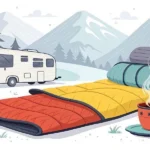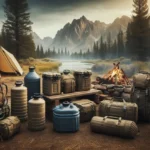
The Best Backpacking Sleeping Bags: Top Picks & Reviews
A sleeping bag can make or break your backpacking trip. It’s your cozy retreat after hiking and your shield against harsh weather. Your sleeping bag ensures a good night’s rest under the stars.
I’ve tested over 35 backpacking sleeping bags during 1,000 nights outdoors. This guide covers the top bags for 2025. You’ll find the perfect mix of warmth, weight, and comfort for your adventures.

Choosing a sleeping bag can be tough. Prices range from $169 to $680. Weights vary from just over a pound to nearly three pounds.
Don’t worry! My expert reviews will help you decide. You’ll get practical advice for an informed choice.
🛌 Stay Warm Outdoors – Shop the Best Sleeping Bags for Camping Now!
Table of Contents
Key Takeaways
- High-quality sleeping bags typically range from $169 to $680
- Average weight of tested models is around 2 lb. 6 oz.
- Down fill power in premium bags ranges from 650 to 900+
- Temperature ratings vary from 0°F to 51°F for different needs
- The Feathered Friends Swallow YF 20 tops our list with a 89.5/100 rating
Understanding Sleeping Bag Temperature Ratings and Standards
Choosing the right sleeping bag can make or break your outdoor experience. Understanding temperature ratings helps select a bag that keeps you cozy. This applies to car camping and rugged backpacking adventures.
EN/ISO Temperature Rating System
The EN/ISO rating system provides standardized temperature ratings for sleeping bags. This system includes two crucial ratings:
- Comfort Rating: The temperature at which an average man can sleep comfortably
- Lower Limit Rating: The temperature at which a standard man can sleep for eight hours without waking
Comfort vs Lower Limit Ratings
Both ratings are important when shopping for a sleeping bag. The comfort rating is typically 10-15°F higher than the lower limit. A bag with a 20°F lower limit might have a 30°F comfort rating.
| Bag Type | Temperature Range | Best For |
|---|---|---|
| Summer | 32°F and above | Warm weather camping |
| 3-Season | 20°F to 32°F | Spring, summer, fall trips |
| Winter | 20°F and below | Cold weather expeditions |
How Temperature Ratings Affect Your Choice
Consider the lowest temperatures you’ll likely encounter when selecting a sleeping bag. For 3-season backpacking, a bag rated around 20°F offers flexibility for unexpected cold snaps.
These ratings assume you’re using a sleeping pad with an R-value of about 5.5. Many backpackers prefer synthetic sleeping bags, which perform well even when damp.
Look for bags that balance warmth and cost for the best budget option. Your sleep temperature, clothing, and tent can affect how warm you’ll feel. Understanding these ratings helps choose the perfect sleeping bag for your adventure.
🔥 Cold Nights? Not Anymore! Get Your Ultra-Warm Sleeping Bag Today!
Down vs Synthetic Insulation: Making the Right Choice
Insulation type is key when picking a sleeping bag for backpacking. Let’s explore the differences between down and synthetic fills. This will help you choose the best bag for your adventures.
Benefits of Down Fill
Down insulation excels in warmth-to-weight ratio. It’s super lightweight, perfect for ultralight sleeping bags. High-quality down bags, like the nemo disco 15, offer excellent compressibility.
Down’s superior loft traps more air. This provides better insulation per ounce, keeping you cozy on chilly nights.
Advantages of Synthetic Fill
Synthetic insulation shines in wet conditions. It keeps insulating when damp, making it reliable in unpredictable weather. Synthetic bags are often cheaper, great for backpacking on a budget.
Weather Considerations and Fill Performance
Your typical backpacking environment should guide your choice. Down is best for cold, dry conditions. Synthetic works better in wet climates.
Some bags, like the nemo disco 15, combine both fills. This offers versatile performance for various weather conditions.
| Feature | Down Fill | Synthetic Fill |
|---|---|---|
| Warmth-to-Weight Ratio | Excellent | Good |
| Compressibility | High | Moderate |
| Performance When Wet | Poor | Good |
| Durability | Long-lasting | Moderate |
| Cost | Higher | Lower |
The best sleeping bag fits your specific needs and backpacking style. Consider your budget, typical weather, and desired features when making your choice.
🏕️ Sleep Like a Dream Under the Stars – Grab Your Camping Sleeping Bag!
Top Sleeping Bags for Backpacking: Our Expert Reviews
I’ve tested 35 sleeping bags over five years in various cold environments. My aim was to find the best bag for every backpacker. This review covers ultralight and budget-friendly options.

The Therm-a-Rest Questar 20F is the best overall sleeping bag. It has a 20°F rating and weighs only 27 oz. With 16.8 oz of 950+ fill power down, it keeps you warm on cold nights.
The Kelty Cosmic Down 20 is a great budget-friendly option. It’s warm down to 20°F and weighs 2 lbs 10 oz. Though heavier than premium bags, it’s perfect for occasional backpackers.
| Sleeping Bag | Temperature Rating | Weight | Fill Power |
|---|---|---|---|
| Feathered Friends Swallow UL 20 | 20°F | 27 oz | 950+ |
| Kelty Cosmic Down 20 | 20°F | 2 lbs 10 oz | 600 |
| Sea to Summit Spark 45 | 45°F | 12 oz | 850+ |
For warm weather, the Sea to Summit Spark 45 is my top ultralight choice. At just 12 oz, it’s ideal for summer trips. Keep in mind, it’s best for mild temperatures.
Sleeping bags come in various shapes and sizes. Options range from mummy-style to unisex bags. The right bag can greatly improve your outdoor experience.
Essential Features of Quality Backpacking Sleeping Bags
The right sleeping bag can make or break your ultralight backpacking trip. Quality features are crucial for a good night’s sleep in the wilderness. Let’s explore what makes a lightweight sleeping bag stand out.
Draft Tubes and Collars
Draft tubes and collars are unsung heroes in top backpacking sleeping bags. They prevent cold air from sneaking in through the zipper and around your neck. These features are game-changers when temperatures drop unexpectedly.
Hood Design and Adjustability
A well-designed hood is essential for lightweight sleeping. It should snug around your head without feeling claustrophobic. The best bags offer easy adjustability, even with gloved hands.
This feature is crucial as we spend about a third of our backpacking time in our bags.
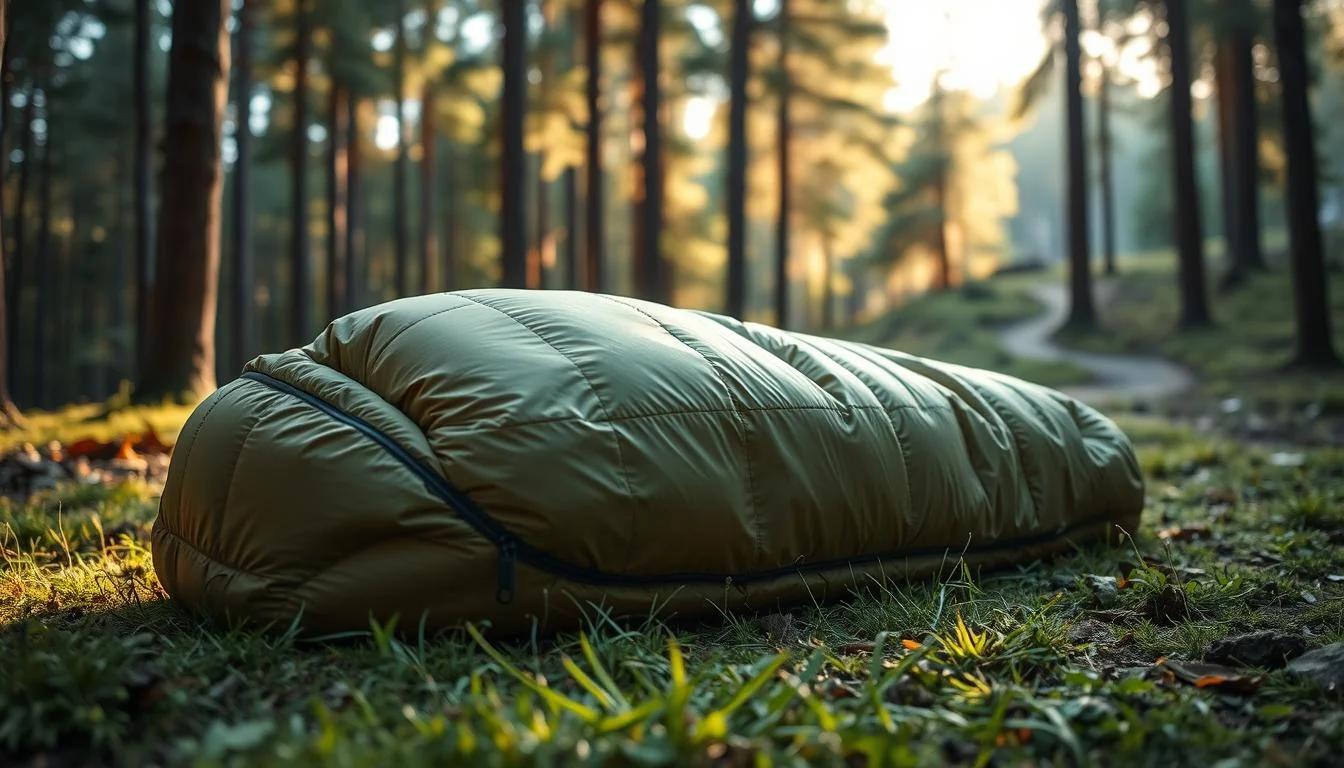
Zipper Systems and Ventilation
Zipper quality can’t be overlooked in backpacking quilts and bags. Smooth, snag-free zippers make getting in and out a breeze. Some top-tier bags offer multiple zippers for customized ventilation.
This is perfect for those warm nights when you need to let some air in.
Real-world testing is key to finding the perfect bag. These features truly shine in challenging conditions. A quality bag can mean the difference between misery and refreshing sleep.
🌙 Cozy, Lightweight & Durable – Find Your Perfect Hiking Sleeping Bag!
Weight and Packability Considerations
Weight and packability are key factors in choosing backpacking sleeping bags. Our tested bags ranged from 13.6 oz to 2 lb 8 oz. Most unisex mummy bags average around 1 lb 6 oz, balancing warmth and portability.
Premium bags offer significant weight savings. The Therm-a-Rest Questar 20F uses high-quality 950+ fill down for excellent warmth. Budget options like the Kelty Cosmic Down 20 use lower fill-power insulation, resulting in bulkier, heavier bags.

Consider your priorities when choosing a bag. Ultralight enthusiasts might prefer a hoodless quilt weighing about 1 lb 4 oz. Others may opt for a heavier bag with more insulation for colder trips.
Bags with the best warmth-to-weight ratios often cost more. However, they can be worth the investment for serious backpackers.
| Sleeping Bag Type | Average Weight | Packability |
|---|---|---|
| Ultralight Quilts | 13.6 oz – 1 lb 4 oz | Excellent |
| Premium Mummy Bags | 1 lb 6 oz – 1 lb 10 oz | Very Good |
| Budget Bags | 2 lb – 2 lb 8 oz | Fair |
The right balance of weight and packability depends on your specific needs. Consider these factors carefully to find your ideal sleeping bag. Your choice can greatly enhance your backpacking experience.
Premium Sleeping Bags: What You Get for Your Money
Premium sleeping bags are top choices for camping and backpacking fans. These high-end bags offer excellent quality and performance. They can greatly improve your outdoor adventures.
High-End Materials and Construction
Top-tier sleeping bags use advanced materials like ultra-high fill power down. They also feature cutting-edge shell fabrics. The Feathered Friends Egret has 950 fill power down, giving great warmth with little weight.
These bags are made with special techniques. For example, differential cut baffles make insulation more efficient.
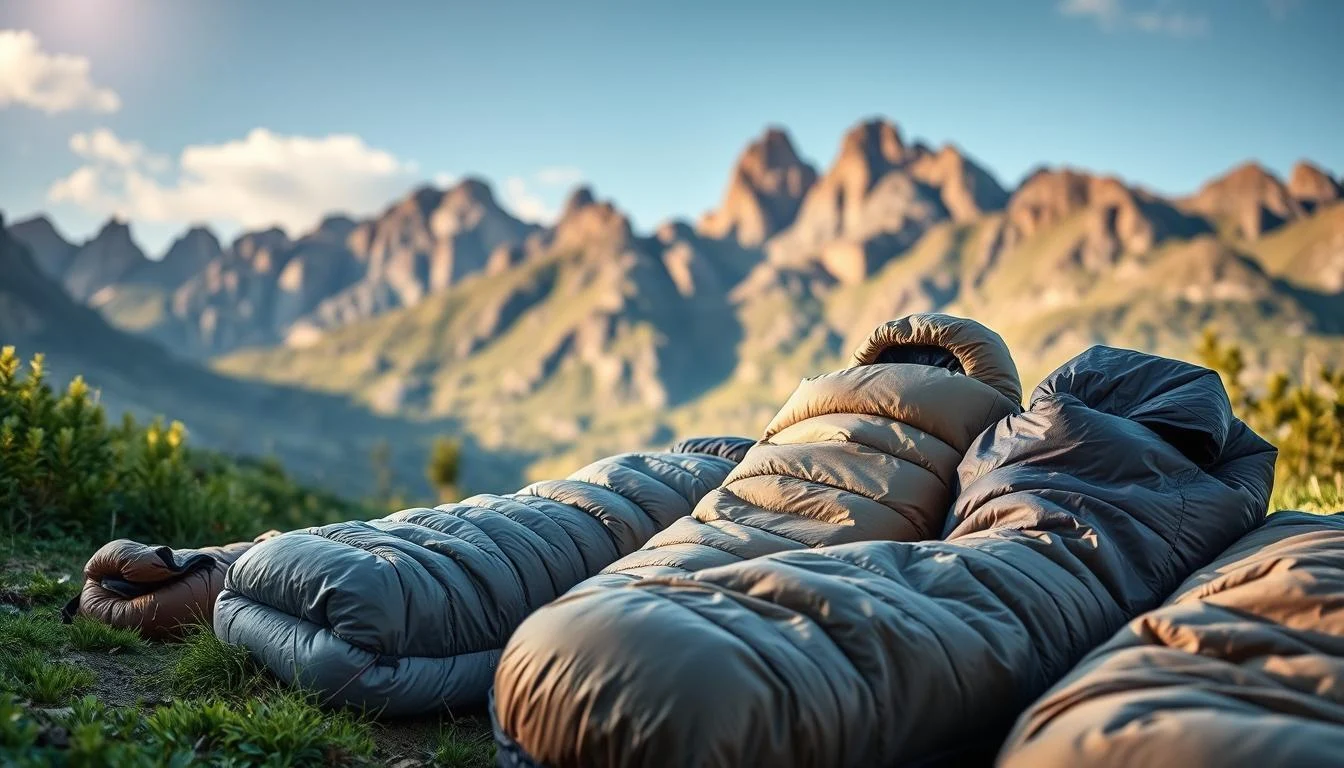
Performance Benefits
The best camping sleeping bags shine in their performance. Premium bags have great warmth-to-weight ratios, which backpackers love. The Therm-a-Rest Parsec weighs just 1 pound 12 ounces but keeps you warm down to 20°F.
These bags are often tougher and more comfortable. They may have ergonomic hoods and draft collars for added coziness.
Long-Term Value Assessment
Premium sleeping bags cost more upfront but can be smart long-term buys. The Nemo Disco is part of their Endless Promise collection. It’s made to be fixed, resold, and recycled.
This focus on lasting quality makes premium bags a great choice. Serious outdoor lovers often find them worth the investment.
| Sleeping Bag | Weight | Temperature Rating | Fill Power |
|---|---|---|---|
| Feathered Friends Egret | 1 lb 11.2 oz | 20°F | 950 |
| Therm-a-Rest Parsec | 1 lb 12 oz | 20°F | 800 |
| Nemo Disco | 3 lb 1 oz | 15°F | 650 |
Budget-Friendly Sleeping Bag Options

Great sleeping bags don’t have to be expensive. Many affordable options offer warmth and comfort for camping trips. Let’s explore some bags that provide excellent value without breaking the bank.
The Kelty Cosmic Down 20 20 is a top pick for budget backpackers. It costs between $150-170 and offers the best warmth-to-weight ratio. With 550-fill down insulation, it keeps you cozy down to 21°F.
For synthetic fill lovers, the Mountain Hardwear Bozeman 15°F is a solid choice. At just over $100, it’s perfect for various camping scenarios. Synthetic bags perform better in wet conditions but are usually heavier.
| Sleeping Bag | Price | Weight | Comfort Rating |
|---|---|---|---|
| Kelty Cosmic Down 20 | $150-170 | 2.6 lbs | 21°F |
| Mountain Hardwear Bozeman 15°F | $100+ | 3.8 lbs | 15°F |
| NEMO Tempo 35°F | $99.95 | 2.5 lbs | 35°F |
The NEMO Tempo 35°F is a budget-friendly option known for its packability. It’s great for backpacking and camping in milder conditions. This versatile bag works well for many outdoor activities.
When choosing a budget bag, consider the trade-offs. You might sacrifice weight savings or extreme temperature ratings. However, you’ll still find options that keep you warm on most adventures.
Shape and Fit: Finding Your Perfect Match
Shape and fit are key in choosing a quality sleeping bag. Your body type and sleeping style matter. Let’s explore options to find your ideal sleeping bag.
Mummy vs Semi-Rectangular Designs
Mummy bags offer excellent thermal efficiency. Semi-rectangular designs provide more room to move. Our comparison shows mummy bags like Western Mountaineering HighLight weigh just 1 pound.
These bags are rated for 35°F. Semi-rectangular bags offer comfort for restless sleepers. However, they may add weight to your pack.
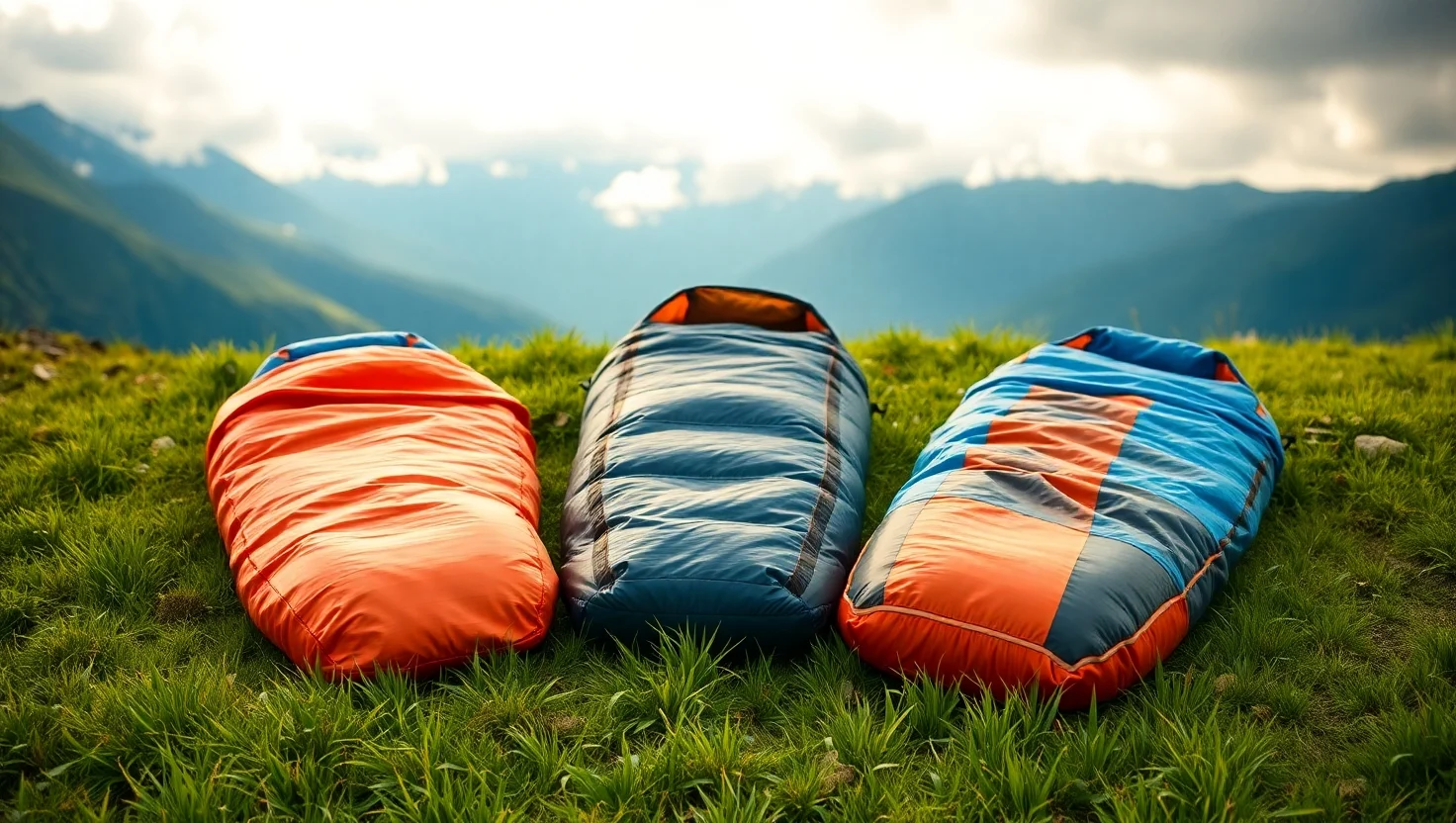
Size Options and Considerations
Sleeping bags come in various sizes for different body types. Consider your height, shoulder girth, and hip width when selecting. Cold sleepers might need a bag with a lower temperature rating.
A proper fit ensures optimal insulation and comfort. Choose wisely for the best sleeping experience.
Comfort for Different Sleeping Positions
Your sleeping position affects which bag shape works best. Side sleepers often prefer roomier bags. Back sleepers may find mummy bags comfortable.
Some manufacturers are creating more comfortable options. These cater to various sleeping styles.
| Sleeping Position | Recommended Bag Shape | Key Features |
|---|---|---|
| Back Sleeper | Mummy | Snug fit, efficient insulation |
| Side Sleeper | Semi-rectangular | More room to move, wider hip area |
| Stomach Sleeper | Rectangular or quilt-style | Ample space, less constriction |
Finding the perfect shape and fit may take time. Many quality sleeping bags balance comfort and performance. This ensures great sleep on your backpacking adventures.
Care and Maintenance for Long-Term Performance
Proper care ensures your camping sleeping bag lasts for years. Maintenance is key to preserving warmth and durability. I’ve tested many backpacking sleeping bags and found this to be true.
Wash your sleeping bag sparingly. Spot clean minor stains when possible. Only wash the entire bag when necessary. Down bags need multiple rinses to remove soap.
Use front-loading machines on gentle cycles for synthetic bags. They handle washing better than down bags.
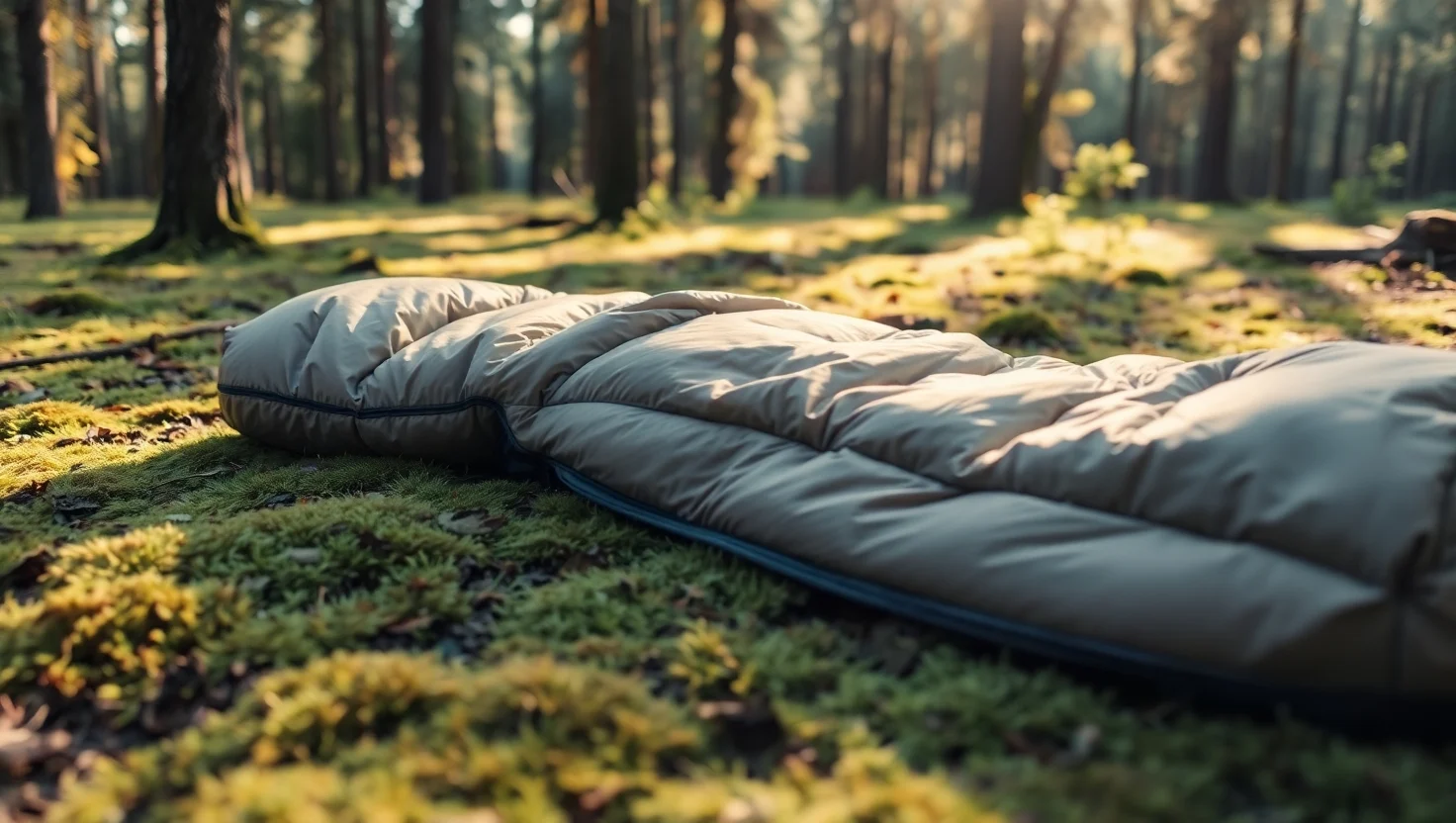
Drying is crucial for bag care. Down bags need low heat and take hours to dry. Synthetic bags dry faster. To restore loft in down bags, use clean tennis balls while drying.
Avoid small stuff sacks for storage. Use a large, breathable space to maintain insulation. This helps preserve your bag’s performance over time.
Regular care extends your bag’s life significantly. Many quality bags can last up to 20 years with proper maintenance. Investing in a good bag is worthwhile for long-term use.
| Bag Type | Washing Frequency | Drying Time | Potential Lifespan |
|---|---|---|---|
| Down | Every 20-30 uses | 6-8 hours (low heat) | Up to 20 years |
| Synthetic | Every 15-20 uses | 2-3 hours | 5-10 years |
Follow these care tips for your sleeping bag. It will remain a reliable companion for many outdoor adventures. Your bag will serve you well for years to come.
Conclusion
Choosing the right backpacking sleeping bag is essential for outdoor adventures. You’ll spend a third of your trip in it. This guide highlights top picks for various needs and budgets.
The Therm-a-Rest Parsec 20 excels in warmth-to-weight ratio. It costs $440-500. For a budget option, consider the Kelty Cosmic Down 20 at $150-170.
Women might prefer the NEMO Disco 15 for comfortable backpacking sleep. Consider temperature ratings, insulation type, and packed size when shopping.
Most backpackers need two bags for different conditions. Down bags are lightweight and compressible. Synthetic options perform better in wet conditions. There’s a sleeping bag for every backpacker, whether you prefer mummy-style or quilts.
🚀 Adventure-Ready Comfort – Buy the Best Sleeping Bags for Any Trip!
FAQ
For “The Best Backpacking Sleeping Bags: Top Picks & Reviews”
Q: What is the best overall backpacking sleeping bag?
A: The best overall backpacking sleeping bag depends on various factors, but one of the top picks is often the Nemo Disco 15. It offers an excellent balance of warmth, comfort, and weight, making it suitable for most backpackers. However, the best bag for you may vary based on your specific needs and preferences.
Q: How do I choose a sleeping bag for backpacking?
A: When choosing a sleeping bag for backpacking, consider factors such as temperature rating, insulation type (down or synthetic), weight, packed size, and your body type. Also, think about the climate and conditions you’ll be camping in. Many backpackers prefer ultralight sleeping bags to minimize pack weight, but ensure it provides adequate warmth for your intended use.
Q: What’s the difference between down and synthetic sleeping bag?
A: Synthetic sleeping bags are generally more affordable, perform better when wet, and are easier to care for. Down sleeping bags, on the other hand, offer superior warmth-to-weight ratio, compress smaller, and last longer if properly maintained. However, they lose insulating properties when wet and are typically more expensive.
Q: What is the best budget backpacking sleeping bag?
A: For those looking for a budget backpacking sleeping bag, options like the Kelty Cosmic 20 offer good value. While it may not have all the features of premium bags, it provides adequate warmth and comfort for most backpacking trips at a more affordable price point.
Q: How important is the temperature rating when selecting a sleeping bag?
A: Temperature rating is crucial when selecting a sleeping bag. Most backpacking sleeping bags are rated using the EN/ISO system, with comfort and lower limit ratings. Choose a bag rated slightly lower than the lowest temperature you expect to encounter. Remember that personal factors like metabolism and sleeping pad insulation also affect warmth.
Q: What are some key sleeping bag features to look for?
A: Important sleeping bag features include a well-designed hood for heat retention, a draft collar to prevent cold air from entering, a full-length zipper for ventilation, and a draft tube along the zipper. Some bags also offer unique features like built-in pillow pockets or stretchy panels for added comfort.
Q: How do I properly care for and store my ultralight sleeping bag?
A: To properly care for your ultralight sleeping bag, store it uncompressed in a large, breathable storage sack when not in use. Clean it according to the manufacturer’s instructions, typically using a front-loading washing machine and gentle detergent. Always air dry or use a low-heat dryer setting. Proper storage and care will extend the life of your sleeping bag significantly.
Q: What’s the best sleeping bag for car camping versus backpacking?
A: Car camping sleeping bags are typically heavier and bulkier but offer more comfort and features, as weight is less of a concern. Backpacking sleeping bags prioritize light weight and small packed size. While some versatile bags work for both, dedicated backpacking bags are usually the best choice for multi-day treks where every ounce counts.
Q: How does a sleeping pad complement a backpacking sleeping bag?
A: A sleeping pad is essential for backpacking as it provides insulation from the cold ground and adds comfort. The R-value of a sleeping pad indicates its insulating power. When paired with a suitable sleeping bag, a good sleeping pad can significantly enhance your warmth and comfort, allowing you to sleep better on a backpacking trip.
Q: What are some of the best backpacking sleeping bags of 2025?
A: While specific models may change, some of the best backpacking sleeping bags of 2025 are likely to include updated versions of popular bags from brands like Western Mountaineering, Feathered Friends, and REI. Look for bags that offer the best balance of weight, warmth, and features. Always check recent reviews and comparisons to find the most up-to-date recommendations.
Source Links
- Your backpacking tent becomes your home among the stars.
- A 20 sleeping bag turns frigid nights into cozy adventures.
- Avoid cold spots with technology that keeps warmth where you need it.
- Ultralight bags prove comfort doesn’t need to weigh you down.
- What do Sleeping Bag Temperature Ratings Mean – Every bag may promise warmth, but excellence shows in the details.
- Down vs. Synthetic Insulation for Backpacking – Our guide to the best helps you sleep soundly in the wild.
- Your favorite backpacking sleeping bag becomes your trusted companion.
- What happens inside the bag determines your night’s success. | Down vs. Synthetic Insulation
- The 7 Best Sleeping Bags for Different Camping Styles and Budgets
- 10 Best Backpacking Sleeping Bags of 2024 (Tested)
- The Best Backpacking Sleeping Bags of 2024, Tested and Revie
- How to Choose the Best Backpacking Sleeping Bag
- The Best Backpacking Sleeping Bags for (Almost) Any Climate
- The best bags on this list earned their reputation.
- Sleeping bags we tested faced nature’s toughest challenges. | Sleeping Bag Weight Comparison Chart
- While many other bags make big promises, quality speaks in the quietest nights.
- Our backpacking sleeping bag comparison reveals what really matters in the wild.
- Traditional sleeping designs meet modern innovation.
- The best budget sleeping bags 2025
- Your complete backpacking kit starts with quality sleep systems.
- The 5 Best Budget Sleeping Bags
- Switchback Travel | How to Choose a Backpacking Sleeping Bag
- How to Choose a Sleeping Bag
- Sleeping bags also protect more than just your sleep – they guard your adventure energy.
- Expert Advice on Choosing the Right Backpacking Sleeping Bag
- Your sleeping bag is one of the most crucial decisions in outdoor gear.
- How to Choose the Best Backpacking Sleeping Bag
- Backpacking Sleeping Bags vs. Quilts: Which One Is Right for You?
- The best sleeping bags on the market turn wild nights into cozy dreams.
Related Articles:
- Stay Cozy: Top 10 Sleeping Bags for Cold Weather Backpacking
- The Best Camping Pillows of 2025: Top Picks for Backpacking Comfort
- 10 Camping Pillows That Will Transform Your Outdoor Sleep
Our Partners: CSKDesignCrafts.com – FitFusioHub.com – DesignersReport.com
This post contains affiliate links, which means I may earn a commission if you make a purchase through these links. There is no additional charge to you! Thank you for supporting my blog so I can continue creating free content each week!







